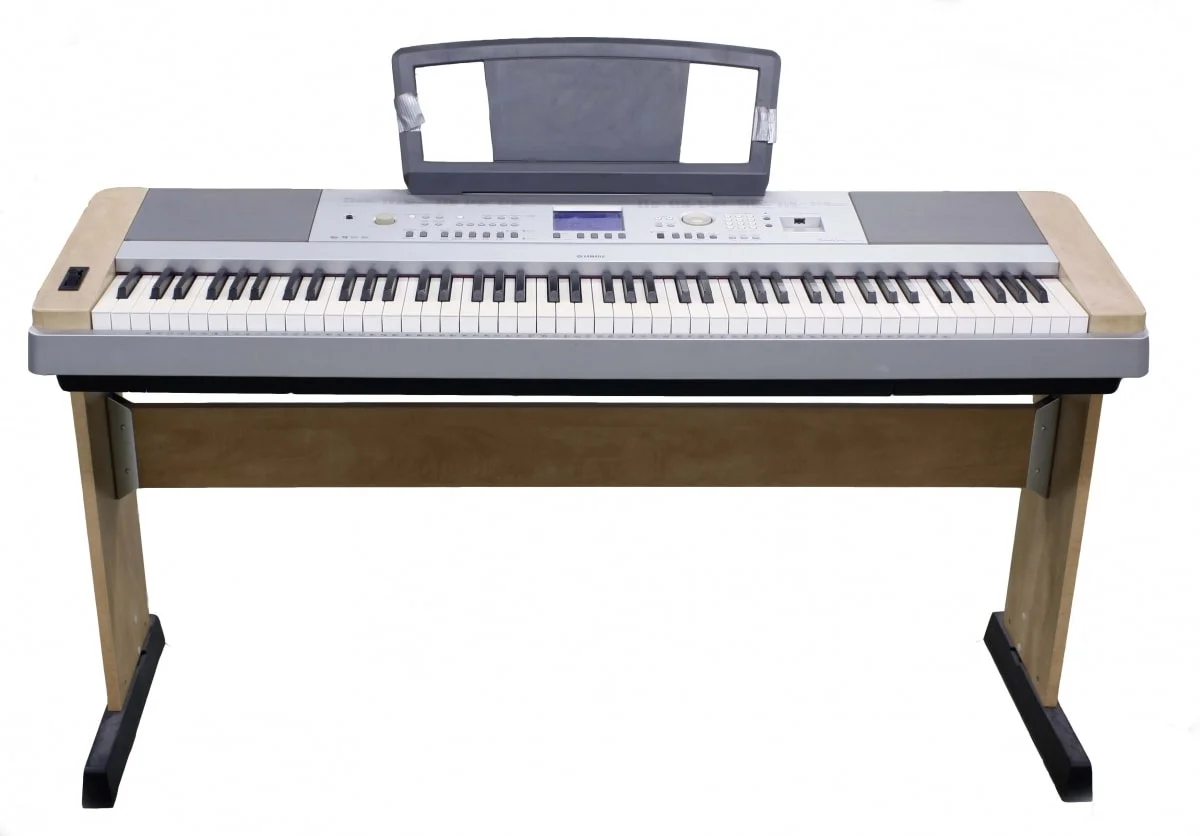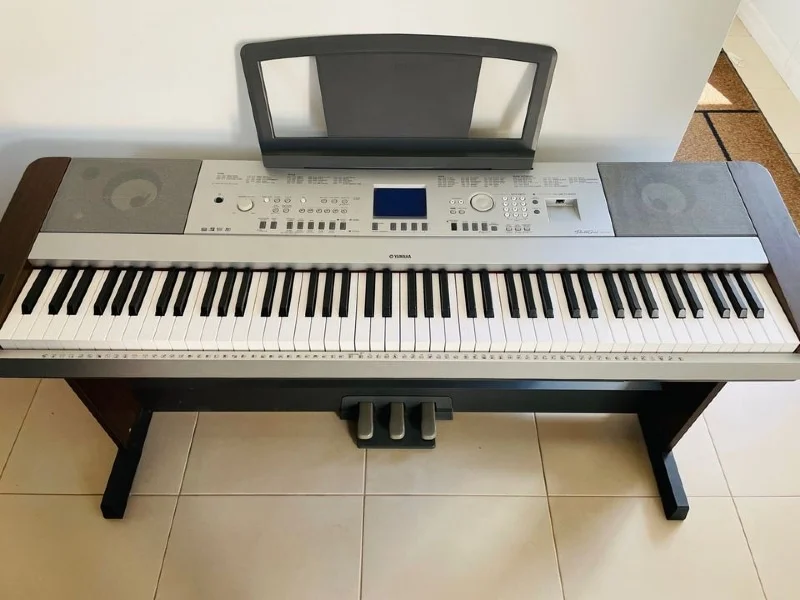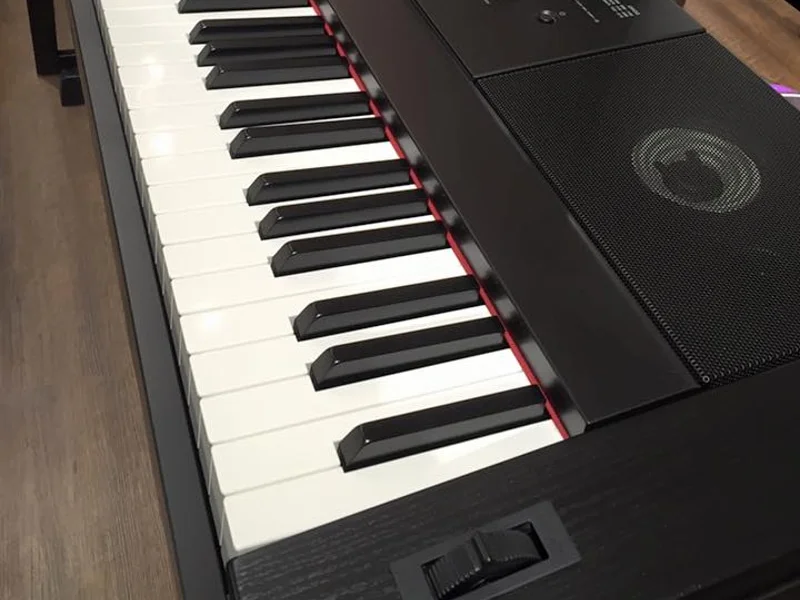In this Yamaha DGX-660 vs DGX-640 comparison, we find out which DGX model offers more value for the money!
I really like the digital pianos in Yamaha’s DGX series. These are affordable, flexible, and great-sounding pianos that are great for any pianist out there. However, since there are so many models in the collection, finding the right option can be quite tough.
That’s why I’ve created this Yamaha DGX-660 vs DGX-640 comparison, where I compare two great DGX models. These two pianos are pretty close in price, with the DGX-640 being the start of the mid-range DGX models and the 660 being on the higher end of the spectrum.
And between the two, I’ll tell you, it was hard to pick a winner. But because of its superior tones and polyphony, the DGX-660 is the winner, even if only by a narrow margin. That said, depending on what you’re looking for in a digital piano, the better pick may vary,
So I’ll get into more of the details of this comparison below. I’ll dive into what makes these pianos great, who they are for, and even some of the drawbacks that they present. That way, it will be much easier for you to choose the perfect one for your needs!
Yamaha DGX-660 vs DGX-640: Comparison Chart




Last update on 2025-04-07 / Affiliate links / Images from Amazon Product Advertising API
Yamaha DGX-660 vs DGX-640: A Head-to-Head Comparison
I compare digital pianos based on three main categories: the tone, feel, and polyphony. These are what I consider to be the most important characteristics of any digital piano that are crucial for those looking to find a decent instrument.
And based on these categories, the Yamaha DGX-660 edges out a win with a score of 3-1. Both of these pianos have a lot of upsides, but since the DGX-660 is a bit more expensive, it comes with a better feature set.
I’ll get into more detail in the sections below. That way, you learn the exact differences between the two models and whether or not the Yamaha DGX-660 is worth the extra investment for you.
Tone
The winner: Yamaha DGX-660
My first consideration was the tone. After all, you always need to ensure that you’re buying a digital piano with good piano tones. And between these two options, the Yamaha DGX-660 is the clear winner. Not only does this model sport the better tone generator, but it also has a better sound library, making it the clear winner.

+Tone Generation
Tone generation has come a long way since the 80s. While there are many pianos (like the DGX-660 and DGX-640) that use sample-based tone generators, they are now equipped with much better samples, making them sound more realistic.
For example, the DGX-640 is equipped with the Live! Grand Piano sound. This means that it has higher-quality recordings of pianos loaded into it. This is why you’ll notice that the DGX-640 sounds much more realistic than many of the other options within the same price range.
I was honestly quite surprised with the tone of the DGX-640 as it’s much more advanced than the tone of the model right before it, the DGX-630. This makes the DGX-640 the perfect middle-ground in the DGX line, striking a balance between quality and affordability.
That said, the DGX-640’s tone engine still doesn’t compete with the DGX-660. The latter is equipped with the Pure CF Sound Engine, which derives its piano sounds from real Yamaha CF Grand Pianos. If you don’t know, these are some of the highest-quality grand pianos on the market, which is why many people love the DGX-660.
The second you play the piano tones on the DGX-660, you’ll hear why it’s one of the more expensive options. The CF Grand Piano samples are simply top-tier and some of the most realistic ones you’ll hear. In fact, the only sample-based tone engine I’ve heard that can beat this model is the CFX sound engine, which you’ll find on the most expensive Yamaha digital pianos.
So, if you’re looking for great tone quality in your piano, I would suggest going for the DGX-660.
+Sound Library
Another great thing about these pianos is their huge sound libraries. They both have more than 500 sounds available for playing. This means you’ll be able to use the instruments for any genre, whether that’s classical music, rock, pop, EDM, or even jazz. If versatility is what you need, then I would say that both pianos have you covered.
That said, the DGX-660 still boasts a slightly larger sound library than the DGX-640. The DGX-660 has a sound library with over 554 sounds, while the DGX-640 only has 535 sounds. This is a fairly small difference, I’m not going to lie, but for many pianists, that extra variety is very important, especially when playing different genres of music.
Feel
The winner: Tie
The way a digital piano feels is very important. For most pianists, if they feel like they’re playing a digital instrument, they won’t be able to be as expressive or technically great on the instrument. Luckily, both of these pianos come with great hammer action systems that mimic how it feels to play an acoustic piano. And for this reason, I gave both pianos a point for this category.
+Hammer Action

Both of these pianos utilize the Graded Hammer Standard or GHS system, that’s a key feature for many Yamaha pianos. This system varies from other fully-weighted keyboards because the weight of the keys is not uniform. If you pay close attention, you’ll notice that the bass keys are slightly heavier than the treble keys.
The reason Yamaha did this is that most acoustic pianos don’t have a uniform weight. So, when you play either the DGX-660 or the DGX-640, it will feel much closer to an acoustic piano than any other model on the market.
On top of that, both of these pianos have a matte finish on the black keys. This is meant to give a textural difference between the white and black keys, which many pianists need when playing the instrument.
The Yamaha DGX-660 and the DGX-640 are both great options when it comes to the feel. While they aren’t identical to acoustic pianos, they come much closer than other models in their price range. This is why you would probably be happy regardless of which piano you end up getting.
Polyphony
The winner: Yamaha DGX-660
The last comparison point I had between these two pianos was the polyphony. This is a very important feature that determines how many sounds the piano can play simultaneously. And if you want a flexible piano capable of handling any type of music, you’d want one with a high maximum polyphony.
The Yamaha DGX-640 only comes with 64-note polyphony. While this polyphony is fine for basic pieces and for beginners, it can be very limiting if you’re playing advanced pieces. This is why the Yamaha DGX-640 isn’t the best option for advanced and professional pianists.
On the flip side, the DGX-660 comes with 128-note polyphony. This isn’t the highest polyphony available, but it’s much better than most pianos on the market today. This gives you a lot of flexibility and versatility while playing, which is another reason why I ended up calling this comparison in favor of the DGX-660.

Yamaha DGX-660 vs DGX-640: The Similarities
You’ll be surprised to learn that these pianos share a fair amount of similarities. For example, I discussed early that they share the same hammer action system and key texture. This is the reason why they both won a point when I compared how the pianos felt and why they are both great options.
On top of that, both pianos are designed to be workhorses. Not only do they come in a wide variety of tones, but they are lightweight and portable. This means you can load either piano into a gig bag and bring it with you to lessons, jams, and even live performances.
But while I liked both of these pianos, there was no denying the slight edge that the DGX-660 has. Since it’s the more expensive model, it’s natural for it to come with more features and be the better overall pick. Though if you’re shopping on a tight budget and don’t need the DGX-660’s extra features, you’ll be more than fine with the DGX-640.
Quick Rundown of the Yamaha DGX-660
- The Pure CF Sound Engine faithfully reproduces the tone of a meticulously sampled and highly acclaimed Yamaha concert grand piano
- GHS weighted action is heavier in the low register and lighter in the high, just like an acoustic piano
- Score display puts music notation of MIDI songs on the screen, helping you play your favorites by following the bouncing ball
- The Piano room lets you choose from a variety of pianos and acoustic settings to create your own personal piano environment
- The 6 track recorder allows you to capture your performances and song ideas, then add additional layers to spice up your pieces
Last update on 2025-04-07 / Affiliate links / Images from Amazon Product Advertising API
Quick Rundown of the Yamaha DGX-640
Product Video
Related Articles to Yamaha Dgx 660
- Yamaha YDP-164 vs DGX-660: Why You Should Go for the DGX-660
- Yamaha DGX-660 vs Roland FP-90: Why the Roland FP-90 Is the Better Pick
- Yamaha DGX-530 vs 660: Why the DGX-660 Is the Better Pick
- Yamaha DGX-505 vs 660: Why the DGX-660 Is the Better Pick
- Yamaha DGX-660 vs DGX-630: A DGX Comparison
- Yamaha DGX-620 vs 660: Finding the Best DGX Model
- Yamaha DGX-660 vs YDP-163: Which Is the Better Piano?
- Yamaha DGX-660 vs Roland Juno DS-88: Which Is the Better Piano?
- Yamaha DGX-660 vs Casio PX-360: Which Is the Better Piano?
- Yamaha DGX-660 vs YDP-144: Which Is the Better Yamaha Piano?
- Yamaha DGX-660 vs Korg Havian 30: Which Is the Better Digital Piano?
- Yamaha DGX-660 vs Casio CGP-700: Which Is the Better Pick?
- Yamaha DGX-660 vs YPG-535: Finding the Best Yamaha Digital Piano
- Yamaha DGX-660 vs P515: Is the P515 Worth the Extra Cost?
- Yamaha DGX-660 vs P-115: Which Yamaha Model Is Better?
- Yamaha DGX-660 vs Casio PX-560: Which Piano Offers More Value For The Money
- Yamaha DGX-660 vs 650: A DGX Comparison
- Korg XE-20 vs Yamaha DGX-660: Finding the Best Digital Piano
- Yamaha P45 Vs DGX-660: A Head-to-Head Comparison
- Yamaha DGX 670 Vs 660: The Distinct Difference In Details You Need To Know About
- Yamaha YDP-103 Vs DGX-660: Which Is The Better Yamaha Piano?
- Casio PX-770 Vs Yamaha DGX-660: Should You Get A Portable Or Console Digital Piano?
- Yamaha P71 vs DGX-660: Can the Amazon Exclusive Beat Out the Premium Model?
- Yamaha P125 vs DGX 660 Comparison: Can the P125 Hold Its Own Against the DGX 660?
References:
- Yamaha DGX-660: https://usa.yamaha.com/products/musical_instruments/pianos/p_series/dgx-660/index.html
- Yamaha DGX-640: https://usa.yamaha.com/files/download/brochure/2/328682/Dgx_640.pdf
Lulacruza is an electronic folk duo operating at the junction of the hypermodern and the ancient. Our music weaves together hypnotic female singing, South American folk instruments and electronic processing, while channeling pulsating waves from the source of creation.
Lalucruza is also a community where you can connect with other music lovers to collaborate, exchange ideas and share knowledge. A platform for who wants to learns the basics of playing piano, guitar, drum masters’ technique, etc.. is the premise of our website.
